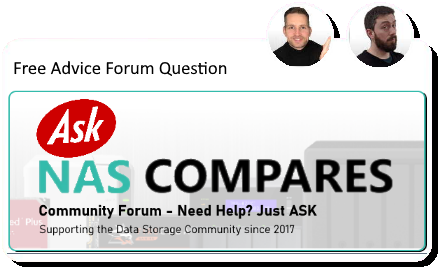
+- ASK NC (https://ask.nascompares.com)
+-- Forum: Q&A (https://ask.nascompares.com/forumdisplay.php?fid=1)
+--- Forum: Before you buy Q&A (https://ask.nascompares.com/forumdisplay.php?fid=2)
+--- Thread: NAS (/showthread.php?tid=12115)
NAS - Enquiries - 06-22-2025
Hi Robbie, I want to start off by thanking you for your excellent videos. There is not enough room for me to share my thoughts. I am most definitely willing to pay you for your professional guidance.
Please follow the link below.
https://www.dropbox.com/scl/fo/scklumxwxg5txe398idxq/ADvenU70gFcogk-huBE7__A?rlkey=xutvfai1uqvi1i6puve1ftaz5&st=d01xb5ii&dl=0
RE: NAS - ed - 06-27-2025
Hi John,
Thank you for the kind words and for sharing the diagram and notes — it’s clear you’ve put a lot of thought into this setup, and your plan makes sense with just a few tweaks that might help optimize both performance and resilience.
Let’s break this down by your goals:
⸻
? 1. Everyday Files (1TB NVMe SSD)
You’re planning to keep your most frequently accessed files on a 1TB NVMe for fast performance — this is a great idea. If the Lockerstor 4 Gen3 supports NVMe caching or storage pools (which it does), you can either:
• Set the NVMe as its own volume for daily use, or
• Use it as a cache layer if your everyday files overlap with the Dropbox dataset.
Since you’re specifically calling out fast transfer for working files, setting it up as a separate volume is the better route.
⸻
☁️ 2. Dropbox Sync (7TB across 2 accounts)
Storing Dropbox data in RAID 5 across Bays 1–3 (using three 12TB drives) is a smart middle ground between capacity and redundancy. You’ll get about 24TB raw, which comfortably fits your 7TB (rounded to ~9TB) needs and future growth.
Note: Just be mindful that syncing large Dropbox accounts will consume bandwidth and CPU cycles — make sure the NAS has the resources for it, especially during syncing and indexing.
⸻
? 3. Archives (10TB old backups on Bay 4, RAID 0)
RAID 0 gives you full capacity but no redundancy — which may be okay for cold/archive data if you’re also backing up that volume externally. And it sounds like you are, so this approach can work as long as the USB backup is reliable and automated.
You could also consider leaving that bay as a standalone basic volume, which avoids the fragility of RAID 0 (if one drive fails in RAID 0, you lose the whole volume).
⸻
? 4. Backup Strategy
Backing up the entire NAS to an external USB drive daily is great. Make sure:
• You’re using versioned backups or snapshots where possible.
• The external drive is encrypted or kept secure if storing sensitive data.
Also consider whether you’d prefer to back up:
• Entire volumes (slower but complete), or
• Just specific shared folders like the Dropbox and Archives.
⸻
? Quick Answers:
• Yes, the Lockerstor 4 Gen3 is a solid choice, especially with SSD support and RAID flexibility.
• RAID 5 for Dropbox data makes sense.
• RAID 0 is okay for archives if you’re backing it up externally. A single-drive setup (no RAID) might be safer though.
• NVMe SSD for working files is ideal for speed.
• Make sure to keep a UPS connected — NAS systems don’t like power cuts.
• And yes — this is all very doable, even if you’re just getting started with NAS.